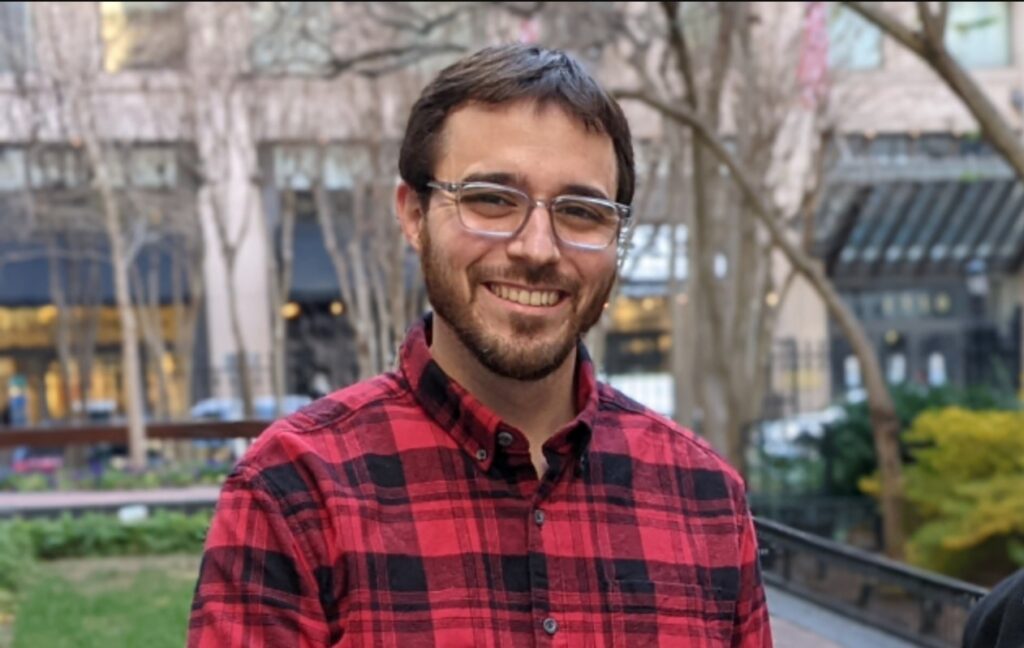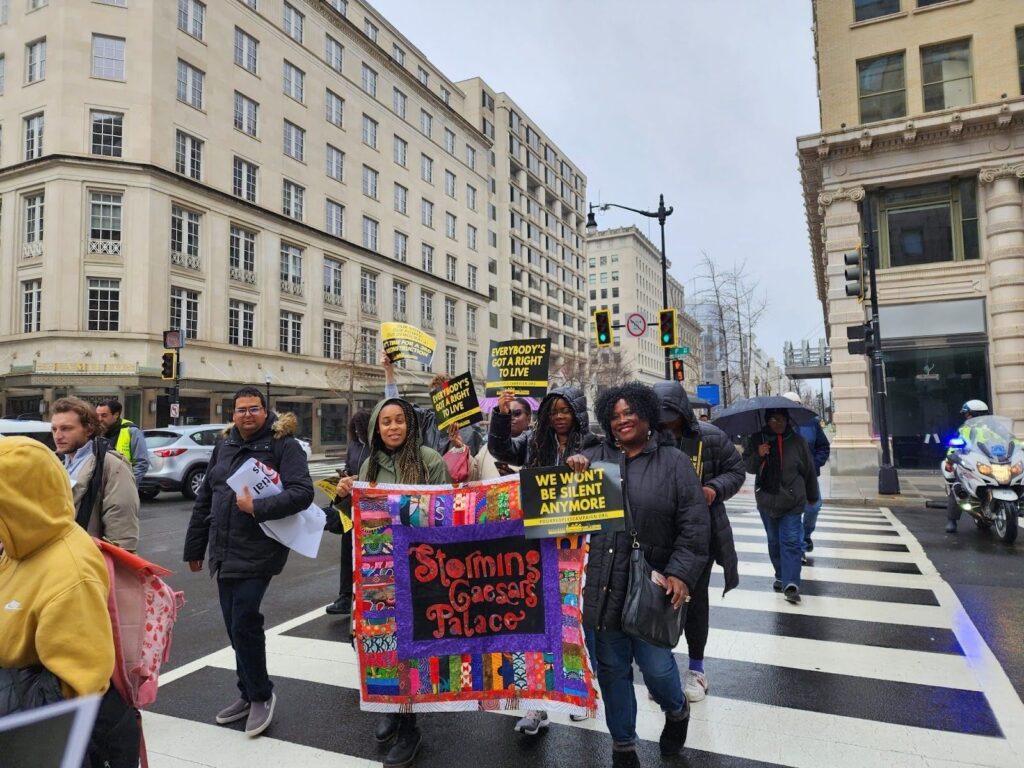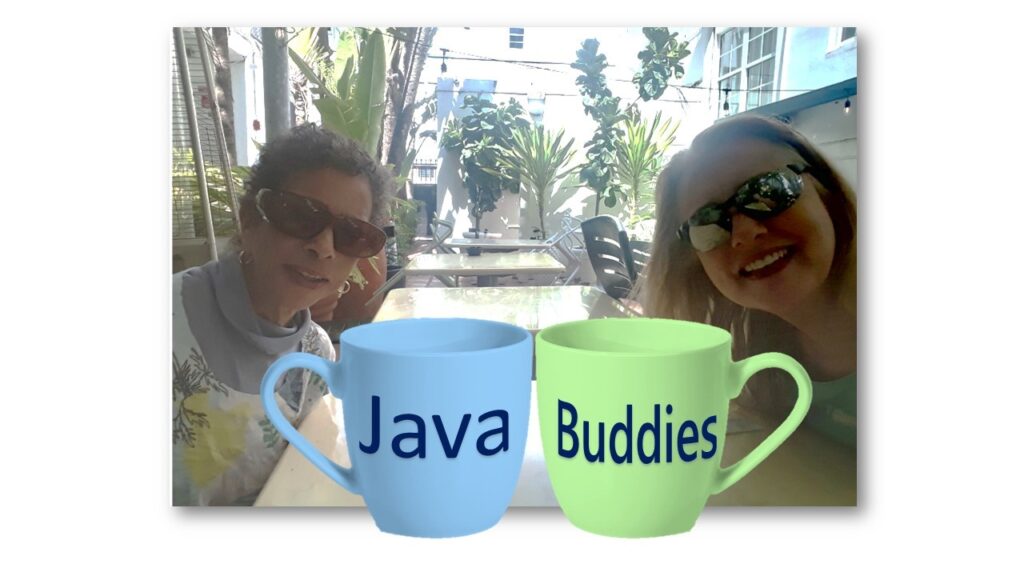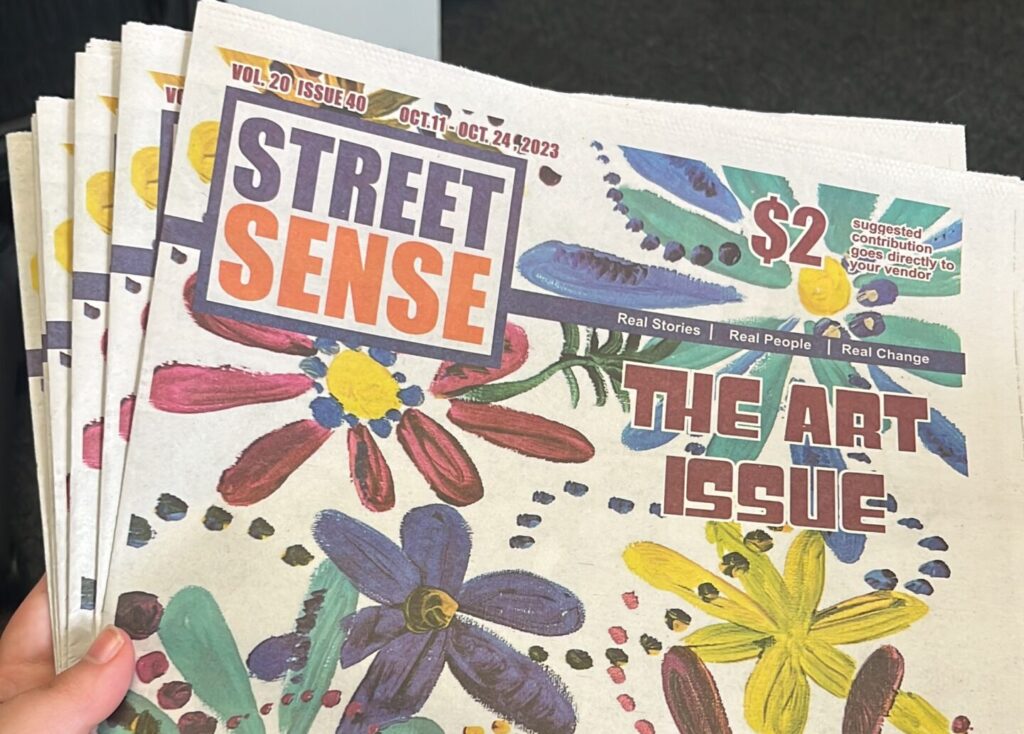As a college student, Eric Falquero didn’t know exactly what he wanted to study. He just knew that he liked to draw.
“I went after an illustration degree, and they didn’t have that, so I did graphic design, ” he said. His graphic design experience got him into working for the school newspaper.
“They wanted someone to make the back cover look really good,” he said.
But once he was in the newsroom, he found himself helping out with a lot more than the back cover.
“Once you’re in there, you help out with everything—run out to take photos or write something quickly,” he said. “I just loved it.”
While still in college, Falquero joined the Street Sense Media team as a graphic design intern in the summer of 2010. Under the leadership of then editor-in-chief, Mary Otto, who occupied the role from 2010 to 2014, Falquero helped out with the layout of the paper, as well as brand marketing and other promotional materials.
In the middle of that summer of 2010, Otto found herself in a bit of a tight spot. The paper’s big issue of the season was coming up, and at the time, D.C. was hosting that year’s Street Soccer USA Cup, bringing soccer players from disadvantaged communities all over the country to the city to play. As the tournament’s official newspaper, Street Sense Media was responsible for enclosing a program for the tournament in its upcoming issue. The problem was, Otto was a journalist who didn’t have much experience with computer layout.
“I was absolutely without help,” she said.
And so, she borrowed Eric Falquero, a young graphic design intern from the marketing department, to help design the program.
“And he, just like magic, put this beautiful program together,” said Otto.
Falquero left his experience interning for Street Sense Media compelled by the idea of a street paper.
“I’d never heard of this model before finding that internship, but once I was there, and saw what it’s all about, I was just really drawn to it,” he said.
In fact, when he went back to school after his summer internship, he was so moved by the street paper model he had witnessed in action at Street Sense Media, he attempted to start his own street paper back in his college town in West Virginia. Unfortunately, upon discovering that he wasn’t much good at the business side of things, he was only able to get two issues out before the paper had to be put to rest.
But in 2011, Falquero found his way back to the Street Sense Media newsroom. Otto, still occupying the role of editor-in-chief, had gotten the chance that year to hire someone to help with the paper’s graphic design. She was thrilled to discover that Falquero was in town again and available.
“It was just an answer to my prayers, that he could come back and work,” she said.
From then on, Otto and Falquero worked closely together on the paper in a small office on the top floor of the Epiphany church. They collaborated often, Falquero focusing mainly on production and Otto concentrating on editing.
“We basically shared one full-time position for several years,” she said. “It was like working in a kitchen or something.”
When Otto left her post as editor-in-chief of Street Sense in 2014 to continue her pioneering work as a medical journalist covering health care and poverty, Falquero was a natural choice for her successor.
“When I left in 2014, I couldn’t have asked for better hands to put the paper in, honestly,” she said.
As editor-in-chief, Falquero implemented several highly important and consequential changes to Street Sense that have proven vital for its continued success and growth as a publication.
For one thing, he took the paper from publishing biweekly to weekly in April 2021. According to Falquero, it was a long, hard road getting there, but it was a decision driven by the desire to induce sales and income for vendors while also being able to “better serve folks” by offering them more up-to-date information.
He also introduced the practice of beat reporting to Street Sense. While editor-in-chief, he grappled with the problem of how the paper could provide the most in-depth and useful stories for its readers. Falquero credited Anna Riley, a former Street Sense intern, with showing him the solution. Riley kept pitching education stories all semester long, because it was an issue area she was interested in. What Riley was able to do by going back to the same sources from one story to the next and developing in-depth knowledge on the subject matter inspired Falquero to formally implement beat reporting, or that “structure of getting folks to focus on particular issue areas,” into the Street Sense Media newsroom.
Another pivotal change Falquero spearheaded was partnering with other local media outlets. Street Sense’s first collaboration with other news outlets occurred in 2014, when Falquero noticed how many vendors were trying to raise the public’s awareness of an annual vigil held on a national day of remembrance to honor those who died while homeless the previous year.
He decided to recruit other street papers around the country to cover events in their own cities being held to honor that day. The experience, Falquero said, “showed me what was possible in partnering with outlets.”
In May 2015, he seized another opportunity to work together with other local newsrooms, as opposed to competitively or in isolation, after taking note of the San Francisco Chronicle’s effort to organize media outlets in the city for a day-long coverage of the homelessness crisis, so that the various outlets weren’t all repeating the same story about the crisis, but covering different aspects of it. Falquero replicated the San Francisco Chronicle’s project by organizing local media outlets in D.C. to coordinate coverage with Street Sense of the homelessness crisis in the city as well. Street Sense has since organized the project, the D.C. homeless crisis news blitz, every year.

While the institutional and operational changes that Falquero implemented while editor-in-chief were important, he said Street Sense Media wouldn’t be what it is without the talented and dedicated people—the interns, vendors, case managers, reporters, editors and other staff members—who make up the paper.
“All of the vendors and other colleagues that I’ve had are just incredible and I’ve been able to learn so much from them,” he said.
When asked about Falquero, the people he claimed to have learned a lot from had a thing or two to share about him, as well.
The Unlikely Photojournalist
Street Sense vendor Sheila White never saw herself as a writer. That all changed when she met Falquero.
“He got me into writing,” she said. “I never thought I would see myself doing stuff like that, by me being homeless, and everything, and when I got with Street Sense, and I met him, he changed my life a lot.”
White might never have enrolled at the University of the District of Columbia as a photojournalism and political science student had she not met Falquero, either, she said.
“Because of him, I want to be a photojournalist,” she said.
While the two were at Street Sense Media together, he steadfastly supported and encouraged White in her writing.
White said how, during the writing process, whenever she would come to Falquero with ideas, he was always there to listen with an open ear and would offer her his insight and input. Moreover, he pushed White to improve her skills and reach her full potential as a writer.
“When I’d write my articles, he’d make me think more, he’d be like, ‘You know, you can do better than this.’”
But in addition to being a mentor, he was also a friend.
“It’s just hard to explain, you know, how a good friend he is. It really is. It’s hard for me to put it in words,” said White. “He’s gonna be truly missed at Street Sense, by mostly all the vendors, especially the old vendors.”
The Community Advocate
When Nkechi Feaster first began working as an advocacy and community engagement specialist at Street Sense, she made an offhand remark to Falquero in a conversation the two had shortly after they had met, in which Feaster casually mentioned her love for old-school movies and TV shows.
“I’m very nostalgic,” she explained.
Feaster didn’t think much of it. But to her surprise, soon after that conversation, Falquero presented her with the first season on DVD of the late ‘70s TV show Mork and Mindy.
Feaster was moved by how Falquero had thought to give her that just based on one conversation that they had with each other. To her, it demonstrated how Falquero truly paid attention and listened to what people had to say to him.
“And from then on,” she said, “I was like, you’re never getting rid of me now.”
Formerly homeless, Feaster would later go on to occupy the role of manager of artistic workshops at Street Sense Media, a role that entailed engaging closely with vendors. Feaster said she often relied on Falquero’s help in learning how to best assist vendors.
“He just had a great rapport with the vendors,” she said, adding that he knew them both on “a business and personal level.”
Feaster eventually moved on from Street Sense Media to become co-owner of Service to Justice, a collective of social service providers, artists, and activists committed to dismantling structural racism through organizational change.
“I think that Eric has a great heart to help,” she said. “That’s something that screams from his core. He wants to help people.”
The Award-Winning Journalist
Journalism, as Mary Walrath-Holdridge described it, is a tough, hard, and brutal industry.
Nevertheless, she’s managed to not just stick it out in that industry, but thrive in it as well, owing in no small part to the mentorship that the now 25 year old reporter found in Eric Falquero when she interned at Street Sense in 2016.
“Even when it was really hard, and I considered switching careers, definitely my experience at Street Sense, under Eric specifically, has been the thing that has…kept me pursuing journalism,” Walrath-Holdridge said.
One day, while interning at Street Sense, she got a tip about the eviction of a 66-year-old blind man confined to a wheelchair, James Jones, from the largest homeless shelter in the D.C. area. Jones was found sleeping on a sidewalk outside of the shelter, the Community for Creative Non-Violence, or CCNV. According to Jones, “[They kicked me out because] they said I couldn’t take care of myself.”
Walrath-Holdridge took that tip and ran with it, diving into a searing months-long investigation into a pattern of mistreatment and wrongdoing at CCNV. By interviewing both current and former residents of the shelter, she gathered eyewitness accounts of physical violence, corruption and manipulation by shelter staff.
She credits Falquero’s support and encouragement, and “him giving me the leeway to investigate what I wanted to do,” for the reporting she was able to do for that article, which ended up winning best “Non-Breaking Story” in the prestigious Dateline Awards from the D.C. chapter of the Society of Professional Journalists.
Eventually, Walrath-Holdridge would go on from her internship at Street Sense to occupy her present-day role as senior editor at Newsweek and to develop an award-winning career in journalism.
The Visual Artist
When Sybil Taylor lost her father in 2015 and was going through a difficult time, she recalled how Falquero was there for her when she needed support.
The two have known each other since 2008. Now, Taylor feels that she can “talk to Eric about anything.”
Taylor is a Street Sense vendor who, in addition to being a writer, is a collage-artist as well. In addition to being a close friend and confidant, she said that Falquero encouraged and supported her in her work.
For many of her articles, Taylor likes to include curated playlists that go along with the theme of the article and add a further layer of depth for the reader. Falquero helped make that vision into a reality for her. Taylor would pick out the songs, and Falquero would put together a playlist in the format of a YouTube video that could then be included at the end of her article.
“It was quite a few videos that he put together for me,” Taylor said.
The Minister Who Gave Up on Writing
Reverend John Littlejohn had given up on writing after growing tired of submitting articles that never ended up being fully edited and published. He’s a licensed and ordained minister who has also been a vendor at Street Sense for the past 11 years.
When he met Falquero in 2018, everything changed.
According to Reverend Littlejohn, one day, Falquero “said he was cleaning computers out, and he found one of my articles in there, half-edited. And he wanted me to come in and see, can he have me fully edit it.”
After that, Reverend Littlejohn started writing again. Falquero, he said, gave him the boost that he needed, and as well as the confidence and courage to continue writing.
The Power of the Paper
Connecting with vendors and assisting them in the writing process is one of the many things Falquero described as having especially enjoyed while serving as editor-in-chief.
“There’s so much talk, at least in our circles, since we cover it so much, about how dehumanizing the experience of homelessness is. How you can feel invisible, how folks can walk right by you,” he said.
He described how, as “an action of reclaiming your identity and broadcasting to the world a piece of yourself,” the act of publishing is “pretty radical” and can serve as a powerful antidote to the dehumanizing experience of homelessness.
Street Sense vendor Robert Warren, who has also referred to Falquero as a mentor of his, echoed that same sentiment.
“When you’re talking about a paper where you have people who are in survival mode… Those folks in the community, you know, they really need to be able to engage their voices and give them a chance to have an opinion and express that opinion and get that out there to their blogosphere,” Warren said.
For Falquero, leaving the paper he spent ten and a half years helping to produce alongside people who endlessly inspired him was never going to be easy.
“I’m sad to pull back from this community a bit, and will miss my colleagues dearly,” he wrote in his goodbye letter to Street Sense Media.
It’s safe to say that they will miss him too.








